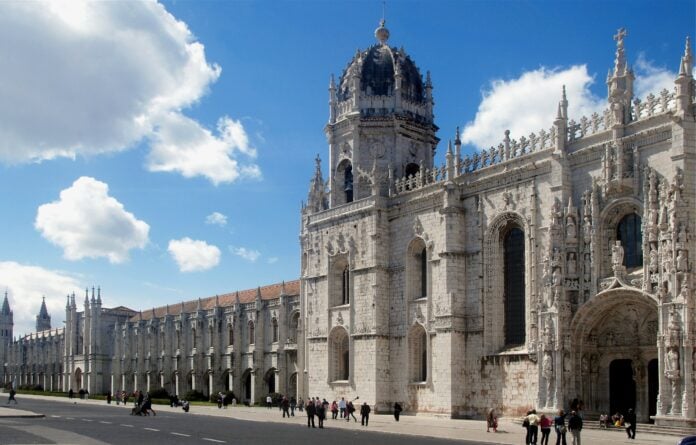If you’ve ever visited Portugal, you’ve probably already heard about the Manueline style! It is the famous Portuguese architectural style! The Manueline encompasses elements that were used to decorate the country’s most treasured churches and monasteries.
The Manueline has roots in the Age of Discoveries and was named in honor of King Manuel I. It quickly became a favorite in the 16th century. Back then, however, it was not distinguished from other Gothic styles and did not even have a name. It was only centuries later that the uniqueness of this architecture was acknowledged.
Have we stirred your curiosity yet?! If so, we encourage you to keep reading! You’ll learn everything there is to know about the history and development of the Manueline style. Furthermore, you’ll discover the nine most prominent Manueline landmarks in Portugal. As a bonus, we’ve included a list of 14 other destinations that will bring value to your trip – that is, if you’re on the hunt for Manueline art!
The Roots of the Manueline Style – The Age of Discoveries
During the reign of Manuel I, also known as the Fortunate, Portugal registered a significant spike in terms of cultural and scientific developments. It was during his reign that the maritime connections between Europe and the Far East were established. Manuel I sponsored Vasco da Gama’s expeditions, as well as the trips made by other famous Portuguese navigators like Pedro Alvares Cabral or Afonso de Albuquerque.
The discoveries that followed are still considered the most significant, having led to newly established connections between peoples from different continents.
Securing the Funds for Manueline Churches
Vasco da Gama created the first link between Europe and Asia by outlining the sea route to India. This discovery led to an economic boost for the Portuguese Empire, primarily thanks to the spices imported from Southeast Asia – mainly pepper and cinnamon.
Pedro Alvares Cabral was the one who discovered Brazil, which further broadened Portugal’s knowledge of the world and expanded its relationship with other countries. Afonso de Albuquerque was a skilled military commander, possibly one of the greatest naval commanders of the time. He was the one to claim mare clausum (a body of water that is under the jurisdiction of a state) in the Indian Ocean.
Apart from the major discoveries mentioned above, we must mention another detail – Portugal’s advantageous position on the southwesternmost point in Europe. It was a popular midway stop for ships sailing between Northern Europe and the Mediterranean.
This position on the map further enhanced the country’s cultural, economic, and scientific enrichment. Lisbon welcomed ships bearing otherworldly treasures – jewels, furniture made with woods unknown to Portuguese people, embroidered silks, and many others.
All these additions led to the development of the Manueline style, also known as the Portuguese late Gothic style. While the term is now mainly used in an architectural context, the Manueline style was once used in various types of visual art, including painting and sculpture.
Needless to say, the construction of the buildings in the Manueline style was financed by Manuel I. He relied on the profit from the spice trade with Africa and India.
The Manueline – Beginnings and Development
In the 15th-16th century, there was no Manueline architecture. This term was actually coined centuries later by Francisco Adolfo de Varnhagen. He used this word to describe the Jeronimos Monastery, naming its style in honor of King Manuel I.
During the reign of Manuel I, however, the architecture in Portugal was not considered to be very different from the architecture in France or other European countries.
The Manueline style was developed in the context of religious expansions – as you’ll soon see, most of the buildings adorned with Manueline motifs were either churches or monasteries. All were built or rebuilt during the reign of Manuel I.
This Portuguese late Gothic style revolved around exaggerating Gothic decorations and mixing them with natural elements, thus stirring people’s interest. Since Portugal lacked the workforce required for such a rapidly expanding architectural project, authorities hired hundreds of craftsmen from different countries. Therefore, they brought along decorative elements they learned about in their own countries and used them in the developing Portuguese style.

The Manueline – a True Style or Not?
This aspect stirred much controversy over the years. Many specialists have debated whether the Manueline was indeed a true style or not. Some argued that since it had no new architectural forms but rather an “assortment of decorative motifs from a host of local and international sources,” the Manueline could not be considered a unique Portuguese style.
Other specialists advise that this aspect is exactly what distinguishes the Portuguese Manueline style from the Late Gothic. First, Manuel I aimed at building many churches in a very short time. Second, the country lacked skilled craftsmen. As a consequence, workers were forced to find creative solutions to problems they had never encountered before.
As Pedro Dias mentions in The Manueline. Portuguese Art during the Great Discoveries, “They over-embellished decorative elements, over-used exuberant forms, joined columns and colonettes to piers for no functional purpose, interpreted common schemes badly, all of which resulted in anti-erudite and even ingenuous art.” In addition, many churches and chapels were (re)decorated by common people who were not in the least experts in architectural decorations.
Donald F. Lach states the following: “Historians of architecture have generally agreed that the Manueline style is a peculiar Portuguese form of flamboyant Gothic which acquired its individuality through lavish use of decorative motifs derived from various European and foreign prototypes.”
The Spread of the Manueline – Beyond Portugal and Architecture
The Manueline style quickly spread beyond Portugal and Europe overall, reaching Morocco and India. The latter actually played a major role in the development of the Manueline. Some Portuguese architects even left for India to continue their work there.
Furthermore, the Manueline style was not used in architecture only. Its motifs were successfully applied and eventually dominated the Portuguese sub-disciplines of sculpture, painting, engraving, jewelry, silverware and goldware, tapestries, and fabrics.
When Manuel I ordered tapestries depicting 26 scenes of Vasco da Gama’s expedition to India, they were described throughout Europe as having “the Portuguese and Indian style.”
Manueline Style Characteristics
As mentioned, the most distinctive characteristic of the Manueline style is excess and exuberance. Here are some elements/motifs that are commonly observed in the decorations of Manueline buildings:
- Large, deep arches with three or more convex curves
- Twisted facades
- Conical pinnacles
- Plant and animal motifs
- Maritime elements
- Symbols of Christianity
- Elements from the discovered lands
- The symbol of King Manuel I

9 Iconic Landmarks Built in the Manueline Style
The characteristics of the Manueline architecture can be further outlined by looking at some of Portugal’s most renowned buildings.
Unfortunately, many churches financed by King Manuel I were damaged or completely destroyed in the 1755 Lisbon earthquake and the disastrous tsunami that followed. Luckily, some are still standing as proof of the enduring Manueline style.
Keep reading to learn about the most prominent ones!
1. Jerónimos Monastery
Address: Praça do Império 1400-206 Lisboa, Portugal
Hours: 10 am – 5:30 pm (January 1 – April 30); 10 am – 6:30 pm (May 1 – September 30); 10 am – 5 pm (October 1 – December 31)
Tickets: from 12 EUR
The Jerónimos Monastery was built in the place of a small church dedicated to Santa Maria de Belem. The construction began in 1501, at the request of King Manuel I, and ended 100 years later. Without even knowing it, the architects and craftsmen built it in a style that would later become the most significant in Portuguese history – the Manueline style.
The monastery has wide arches and windows separated by thin, delicate mullions (vertical elements that divide windows). The columns featured Plateresque-style ornamentation (an artistic movement that developed in Spain between the late Gothic and early Renaissance).

The vast square cloister was adorned with dynastic symbolic motives, including the coat-of-arms and the cross of the Order of Christ. The inside walls of this cloister were also decorated with elements that would later become characteristic of the Manueline style.
The most prominent Manueline structures are the two main doorways built in cretaceous limestone. They also exhibit European and Moorish motifs and display Renaissance, Plateresco, and Romantic Revivalism influences.
Today, the structure of the monastery is similar to the original one, except for the neo-Manueline towers, the cupola, as well as the neo-Manueline tombs of Vasco da Gama and Luis de Camoes.
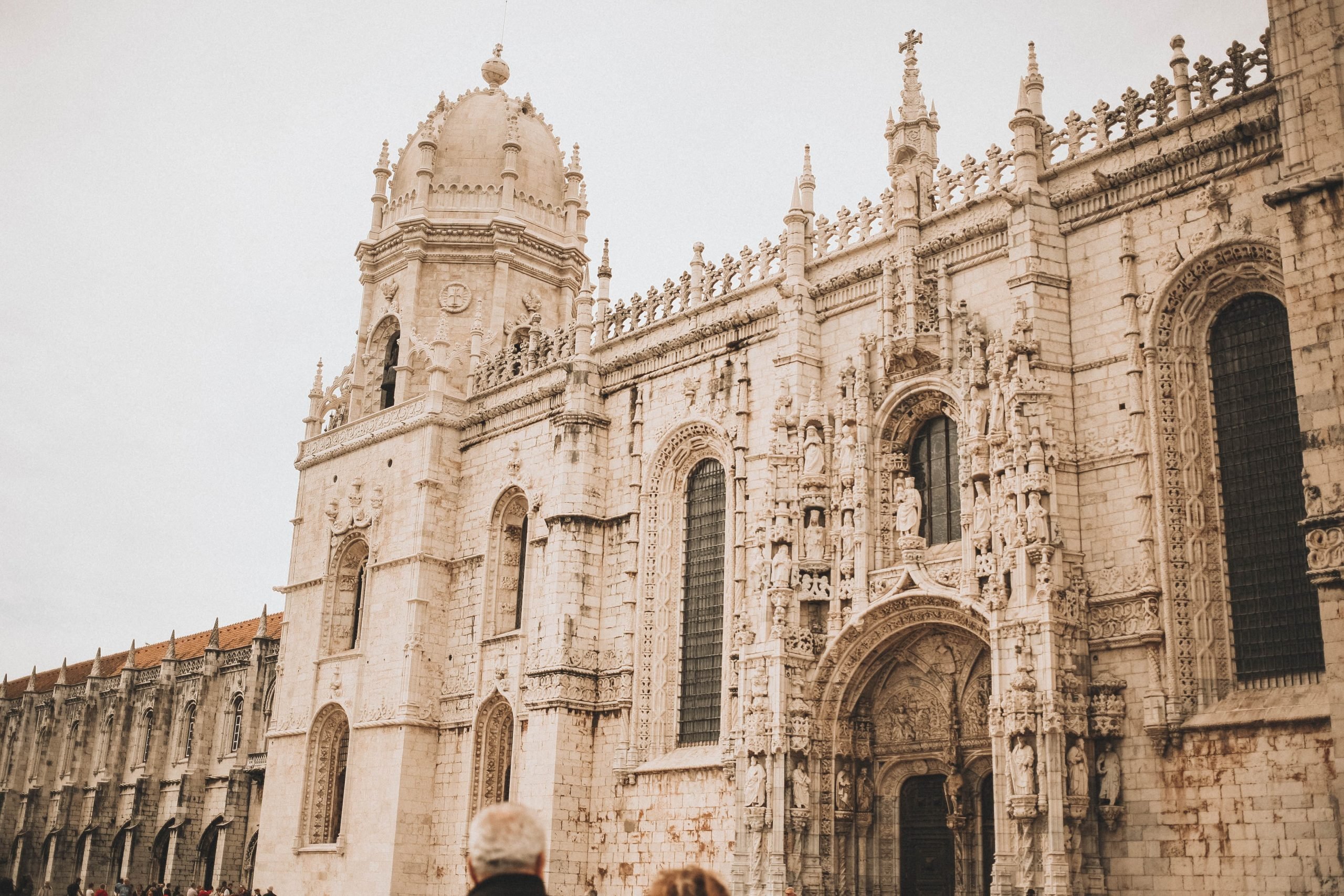
2. Belém Tower
Address: Av. Brasília, 1400-038 Lisboa, Portugal
Hours: 10 am – 5:30 pm
Tickets: 8 EUR
Alongside the Jeronimos Monastery, the Belém Tower is the most famous Manueline structure in Lisbon. Its construction began in the 16th century. Before Manuel I came to power, King John II had planned to create a strong fort at the entrance of the River Tagus because, in his opinion, Lisbon wasn’t adequately protected. King John II died before he could execute his plan, so Manuel I took matters into his own hands and financed the building process.
The most noticeable Manueline elements incorporated in the structure of the BelémTower are the armillary spheres at the tower’s entrance displaying decorative elements representative of this Portuguese style.
The interior of the main bastion has a circular staircase and vaulted ceilings supported by masonry arches. Although most elements are Manueline, those added during the tower’s restoration in the 1840s are Neo-Manueline.
Over the years, specialists have argued regarding the influences observed in the tower’s architecture. Some have suggested that it is strongly influenced by Islamic and North African prototypes, particularly the cupolas and balconies. Others argue that the Belem Tower is similar to Indian structures like the palace of Udaipur in Rajasthan or the temple of Politana in Gujarat.
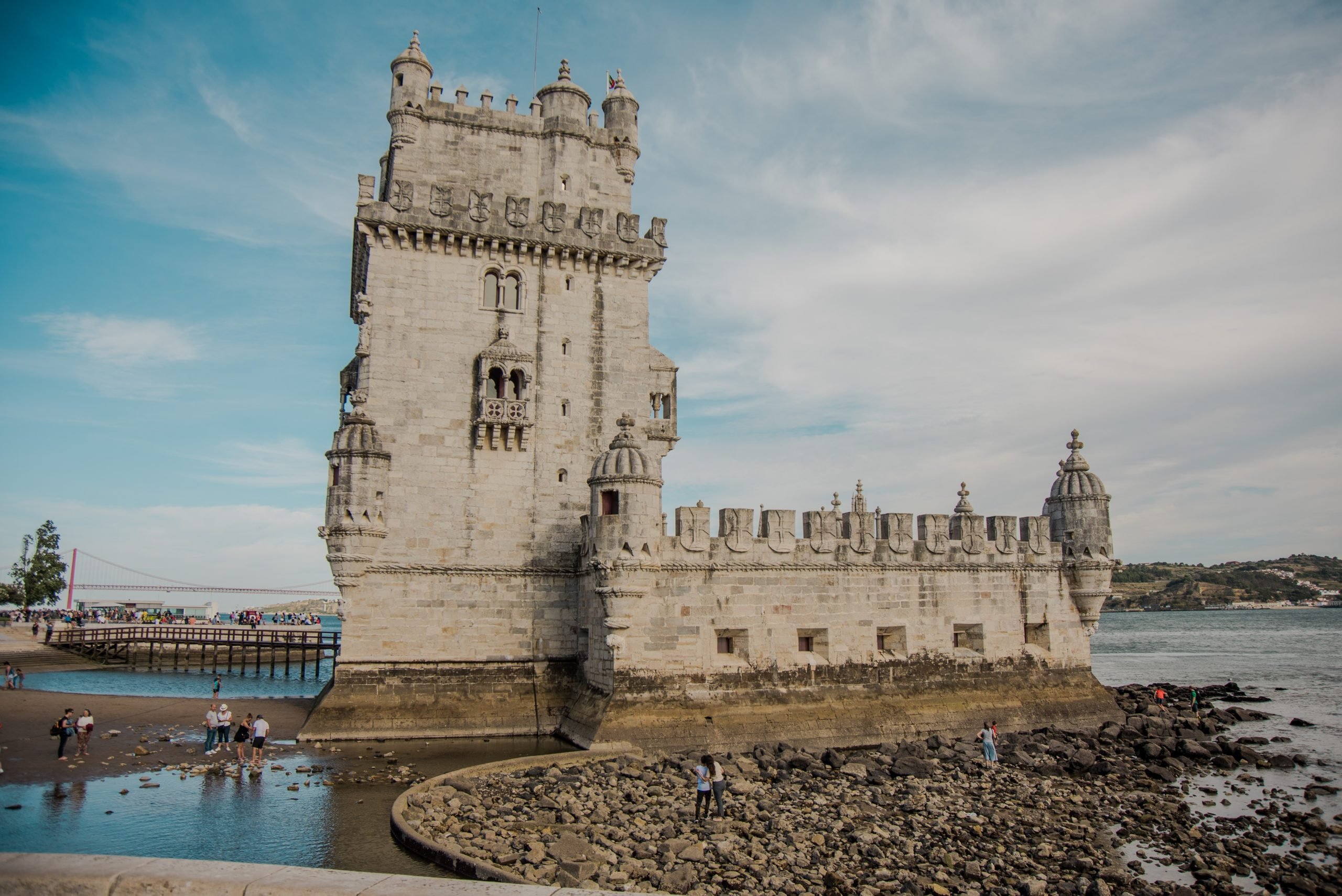
3. Church of Nossa Senhora da Conceição
Address: Rua da Alfândega 108, 1100-585 Lisboa, Portugal
Hours: Monday to Saturday: 8 am – 11:30 pm; Sunday: 10 am – 11:30 pm
Like other churches displaying Manueline elements, the Church of Nossa Senhora da Conceição, was built under the reign of Manuel I.
What makes it stand out as one of the greatest Manueline buildings is its portico (a porch that leads to the entrance of the building, which is either enclosed by walls or supported by columns). This famous portico is adorned with Manueline motifs, displaying sculptures of the Anjo da Anunciacao and Virgem, as well as armillary spheres and the cross of the Order of Christ.
The whole facade is decorated with plant motifs, animals, angels, canopies, and other similar elements. The windows that flank the portico exhibit vegetal motifs as well, which continue to the pillars that extend to the pinnacles. The lateral pillars display yet again ropes and vegetal elements.
4. Convent of Christ
Address: Igreja do Castelo Templário, Estr. do Convento 8, 2300-000 Tomar, Portugal
Hours: 9 am – 5:30 pm (October – May); 9 am – 6:30 pm (June – September)
Tickets: 10 EUR
The Convent of Christ is located in Tomar in the Santarém district. This structure, as well as the castle, isn’t only a Manueline gem – it also exhibits Romanesque, Gothic, and Renaissance influences.
The most prominent Manueline structure of the Convent of Christ is its entrance. Its architectural complexity takes one’s breath away! The interior of the church is also enriched with Manueline sculptures and paintings that were added under the orders of King Manuel I.
Furthermore, the nave (the central part of the church that accommodates the congregation) is also largely Manueline. The rectangular nave of the Convent of Christ is decorated with gargoyles, statues, and ropes, as well as the emblem of King Manuel I and the cross of the Order of Christ.
Another trademark of Manueline architecture one can notice while visiting the Convent of Christ is Janela do Capitulo (the Window of the Chapter House), which is covered in ropes, corals, vegetal motifs, and yet again the symbol of Manuel I and the cross of the Order of Christ. At the bottom, one can see a human figure – it probably depicts Diogo de Arruga, the designer.
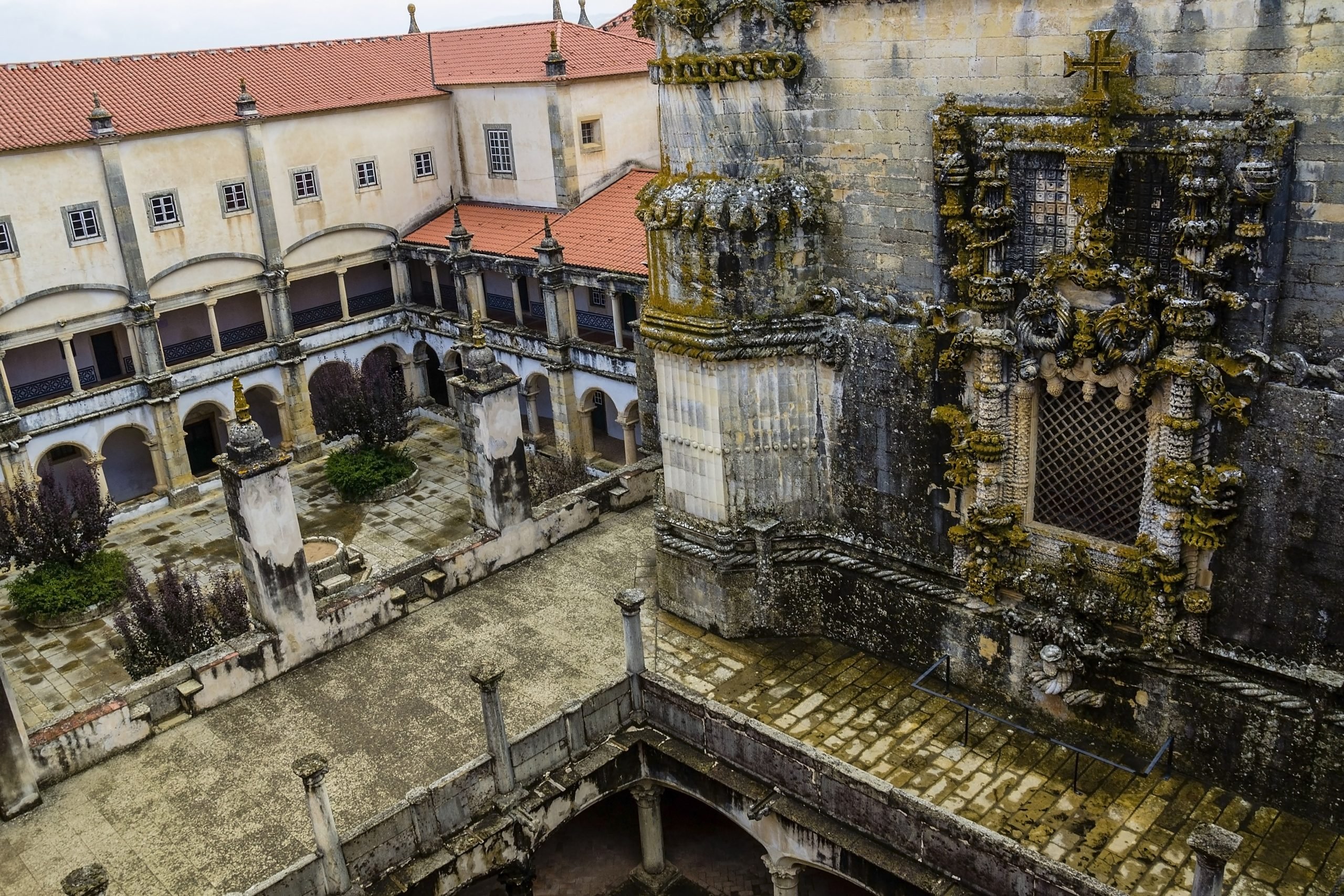
5. Monastery of Batalha
Address: Largo Infante Dom Henrique, 2440-109 Batalha, Portugal
Hours: 9 am – 6 pm (October 16 – March 31); 9 am – 6:30 pm (April 1 – October 15)
Tickets: 10 EUR
The Monastery of Batalha, located in the district of Leiria, is yet another Manueline landmark. It was built after Portugal’s victory in the battle of Aljubarrota. The construction began in 1386 and was finished almost 150 years later, around 1517.
Since at least 15 architects (not all Portuguese) worked on this project over more than 100 years, it is unsurprising that the monastery features various styles, including the Flamboyant Gothic style, the Rayonnant Gothic style, and, naturally, the Manueline style.
The original design was altered several times. For example, the octagonal rotunda of The Unfinished Chapels (As Capelas Imperfeitas) was first built in a Gothic style. Later on, however, it was fully rebuilt in a Manueline style, displaying the representative motifs: winged angels, ropes, tree stumps, armillary spheres, and florid projections.
There’s also a motto added to the construction saying Leauté faray tam ayaserei, which translates as “I will always be loyal” and serves as King Manuel I’s dedication to King Edward, his predecessor. The motto is found in over 200 different places.

6. Sintra National Palace
Address: Largo Rainha Dona Amélia, 2710-616 Sintra, Portugal
Hours: 9:30 am – 6:30 pm
Tickets: 13 EUR
Although Sintra is mostly known for its colorful Palacio da Pena, the city is actually filled with castles, of which the Sintra National Palace is a must-see in terms of Manueline elements.
The castle was once the residence of the Moorish Taifa of Lisbon rulers and subsequently of King Afonso Henriques during the 12th century. Back then, however, the castle was quite different from the one we can visit today. It wasn’t until the 15th and 16th centuries that the building was heavily decorated with additional Gothic, Manueline, and Mudéjar elements.
One can notice Manueline influences on the mullioned windows, as well as in Sala do Cisnes (the Swan Room). King Manuel I also financed the construction of Sala dos Brasões (the Coats-of-Arms Room) and Ala Manuelina (Manuel’s Wing), both displaying evident Manueline elements (particularly on the windows).
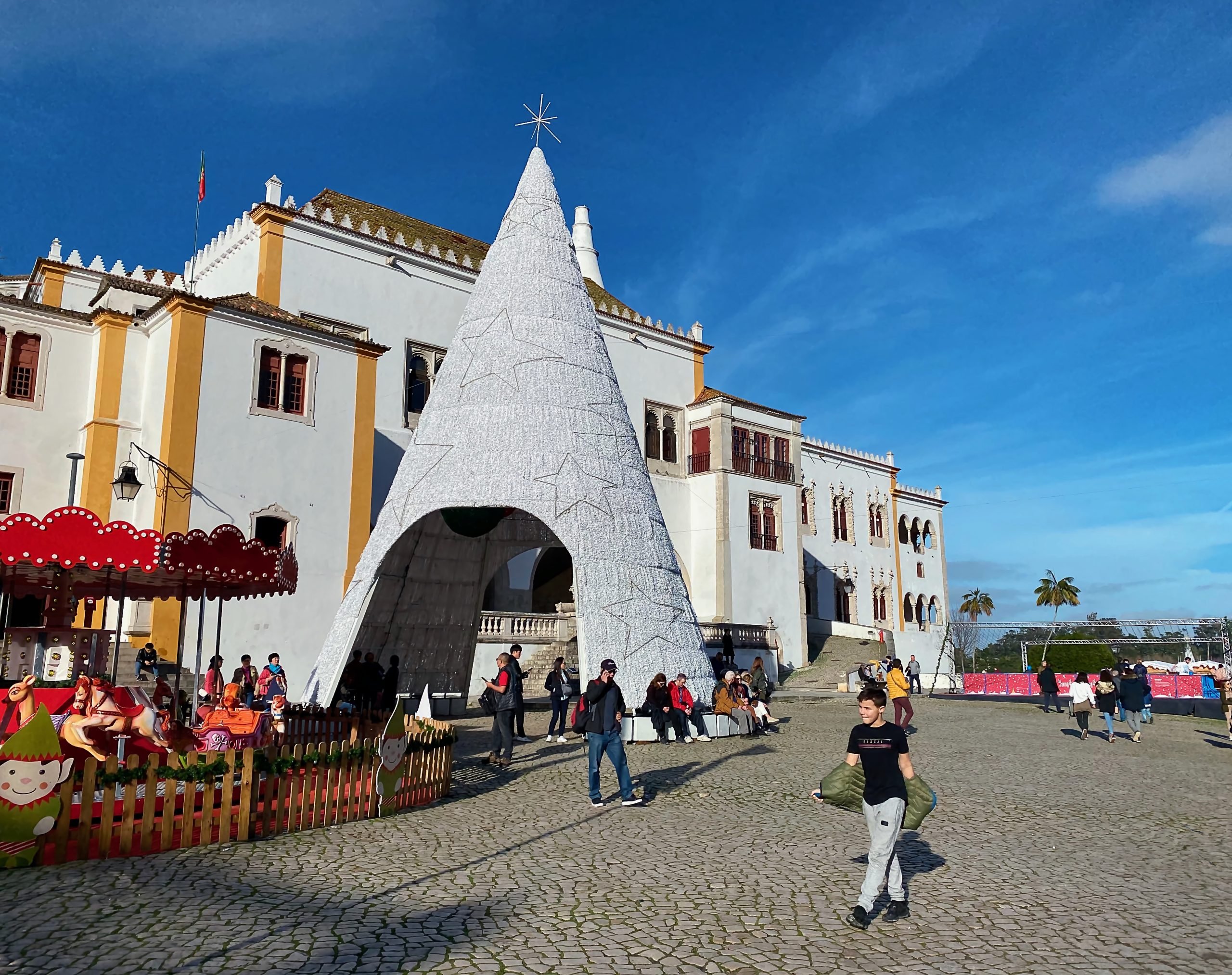
7. Monastery of Jesus
Address: R. Acácio Barradas 2, 2900-197 Setúbal, Portugal
Hours: Tuesday to Saturday: 10 am – 5 pm; Sunday: 3 pm – 7 pm (June – September) and 2 pm – 5 pm (October – May); Closed on Mondays
Tickets: 3 EUR
The Monastery of Jesus is located in the city of Setubal. Its construction began during the reign of King John II. After his death, King Manuel I financed the construction work of a building that would soon become one of the country’s most important Manueline landmarks. This church is, in fact, the first building covered in Manueline motifs, so its significance in the development of this style is priceless.
The South facade of the monastery has a rectangular nave and a polygonal apse. The outer walls of the nave and apse are delineated by buttresses (a structure that has the goal of supporting the wall) decorated with gargoyles and twisted pinnacles.
The columns one can notice in the interior of the church have a spiral form, which would later become a distinctive characteristic of the Manueline style. Furthermore, the church is also covered in twisted ropes that point to the beginnings of the Manueline style.

8. Guarda Cathedral
Address: Praça Luís de Camões, 6300-714 Guarda, Portugal
Hours: 9:30 am – 1 pm; 2 pm – 5 pm
Tickets: 1 EUR
The Cathedral of Guarda is located in Guarda, Portugal. Its construction history spans over two centuries.
At first, the building was envisioned as having Gothic elements only. The building process was extremely slow. Under King Manuel I’s reign, however, the construction progressed significantly, the cathedral being almost finished in just a few years. During that time, as you’ve probably guessed, workers adorned it with a myriad of Manueline motifs (on the windows, the rib vaulting, the spiraling columns).
Over the next centuries, various architects decided to decorate the cathedral with elements derived from other architectural styles. In the 19th century, Rosendo Carvalheira decided to remove all these additions so that the cathedral remained a traditional Gothic/Manueline building.

9. Church of Saint Francis
Address: Rua do Infante D. Henrique, 4050-297 Porto, Portugal
Hours: 9 am – 6 pm
Tickets: 7,50 EUR
The Church of Saint Francis takes travelers to the North of Portugal, as it is an outstanding monument in Porto. The construction of the church began at the end of the 14th century and was finished in 1425. Its original design was Gothic in essence.
Today, the building looks almost identical to the original version in terms of style. Nonetheless, various additions designed by other architects offered it a distinctive look. For example, Manuel I ordered the construction of the Chapel of St John the Baptist, which was done in the Manueline style.
Other Manueline Locations for Architecture Enthusiasts
The buildings we’ve described above are the most iconic Manueline landmarks! However, many other hidden gems bear either Manueline or neo-Manueline motifs and decorations.
If you’re passionate about architecture and want to learn more about the Manueline style, you can even outline a route throughout the country that will take you to both hot tourist spots and less-known destinations!
To make things easier, we’ve prepared a list of churches and museums you can visit to become the ultimate expert in Manueline architecture and art!
- Igreja de São João Batista – Vila do Conde, Porto
- Mosteiro da Santa Cruz – Coimbra
- Casa dos Bicos – Lisbon
- Sao Jorge Castle – Lisbon
- Palacio da Pena – Sintra
- Igreja Matriz de Cheleiros – Mafra
- The Castle of Torres Vedras – Torres Vedras
- Convento de Santo Antonio do Varatojo – Torres Vedras
- Igreja de São João de Alporão – Santarém
- Torre das Cabacas – Marvila
- Igreja dos Lóios – Évora
- Igreja de Nossa Senhora da Anunciação – Alentejo
- The Navy Museum – Lisbon (for those who want to learn more about the Great Discoveries, as the museum has a rich collection of vessels and nautical instruments)
- The National Museum of Ancient Art – Lisbon (for those interested in Manueline art – paintings and sculptures, as well as gold and silver pieces bearing Manueline motifs)

